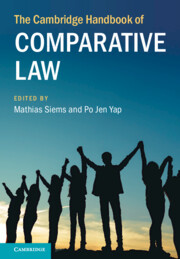Book contents
- The Cambridge Handbook of Comparative Law
- The Cambridge Handbook of Comparative Law
- Copyright page
- Contents
- Figures
- Tables
- Contributors
- Preface
- Abbreviations
- 1 Introduction
- Part I Methods of Comparative Law
- 2 Traditional Methods
- 3 Historical-Jurisprudential Methods
- 4 Critical Methods
- 5 Culture and Comparative Law Methodology
- 6 Linguistic Approaches
- 7 Qualitative Fieldwork
- 8 New Institutional Economics
- 9 Empirical Methods
- 10 Machine-Learning Methods
- Part II Legal Families and Geographical Comparisons
- Part III Central Themes in Comparative Law
- Part IV Comparative Law beyond the State
- Index
8 - New Institutional Economics
from Part I - Methods of Comparative Law
Published online by Cambridge University Press: 26 January 2024
- The Cambridge Handbook of Comparative Law
- The Cambridge Handbook of Comparative Law
- Copyright page
- Contents
- Figures
- Tables
- Contributors
- Preface
- Abbreviations
- 1 Introduction
- Part I Methods of Comparative Law
- 2 Traditional Methods
- 3 Historical-Jurisprudential Methods
- 4 Critical Methods
- 5 Culture and Comparative Law Methodology
- 6 Linguistic Approaches
- 7 Qualitative Fieldwork
- 8 New Institutional Economics
- 9 Empirical Methods
- 10 Machine-Learning Methods
- Part II Legal Families and Geographical Comparisons
- Part III Central Themes in Comparative Law
- Part IV Comparative Law beyond the State
- Index
Summary
This chapter explains how New Institutional Economics (NIE) presents an innovative, interdisciplinary approach for topics of comparative law. It discusses the core principles of NIE and how they relate to the principles of comparative law. New Institutional Economics is a natural partner to comparative law and is especially useful in the study of law in context. The chapter discusses the contribution that the combined approach of NIE and comparative law brings to the scholarship of law. NIE provides ‘institutions’ as an easily understandable tertium comparationis. The chapter concludes with a call to add NIE to the comparative law methodological toolbox as a strategy to develop a sound analytical framework through which to better understand and more aptly rationalise the divergences and convergences observed in the laws of different countries.
- Type
- Chapter
- Information
- The Cambridge Handbook of Comparative Law , pp. 133 - 156Publisher: Cambridge University PressPrint publication year: 2024

